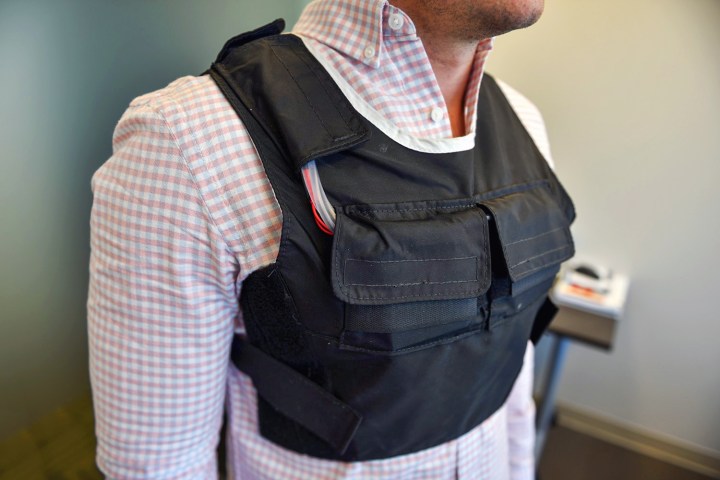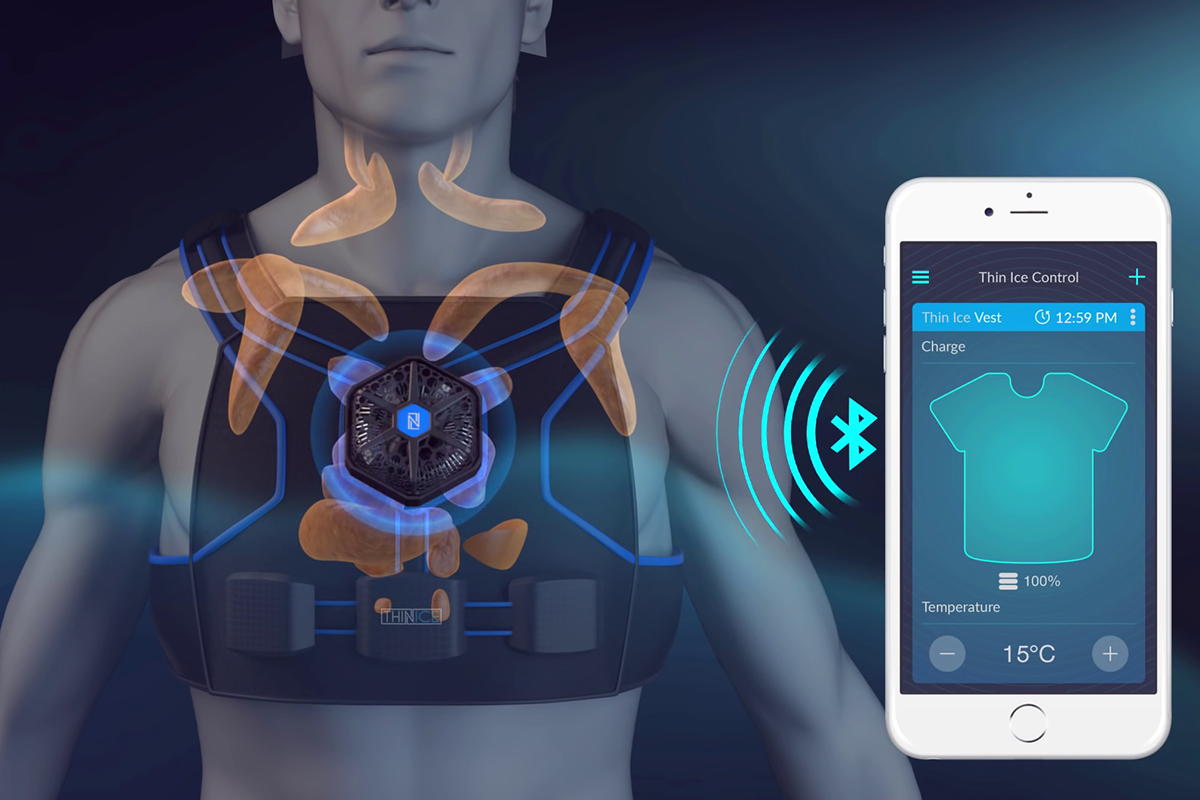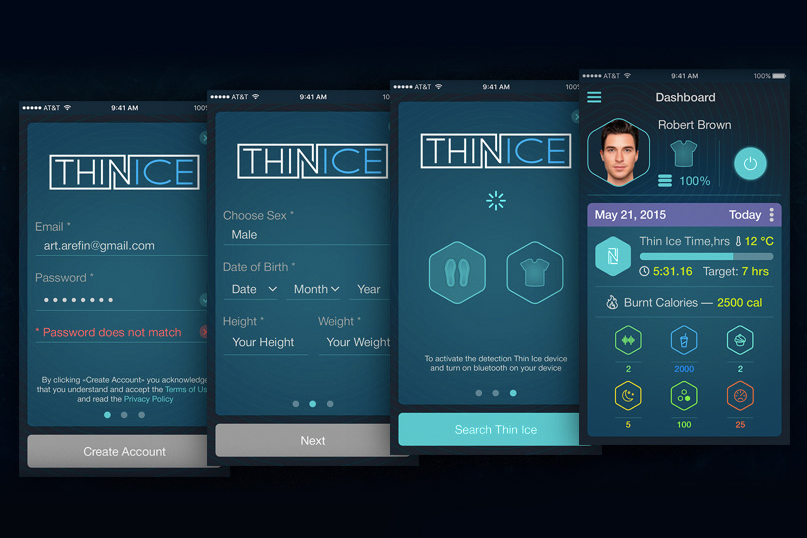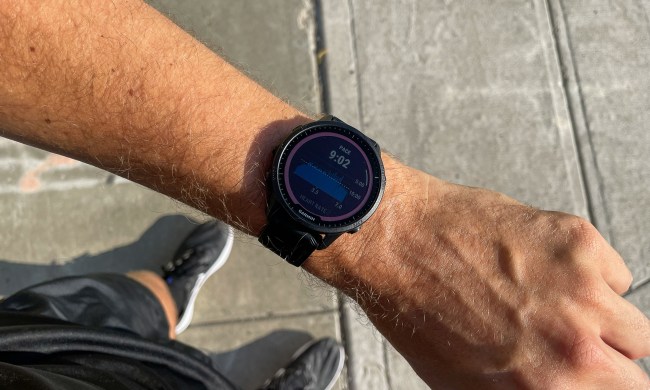
The startup estimates that users can burn up to 500 or even 1,000 calories per day simply by wearing it. These are lofty claims, even if they are only estimates, but apparently there’s some science to back up what the Thin Ice purports to do. We took a closer look at this so-called fat-trimming gizmo to understand how it might pull all that off.
Cool as a fan
Thin Ice purports to stimulate thermoreceptors in the body, to trick it into thinking it’s colder than it really is. Since the body naturally burns calories to produce heat to stave off the cold, the wearer’s metabolism gets a little boost, and the weight starts to slowly fall off over time — or at least that’s how the vest’s creators tell it. Thin Ice has faced a fair share of criticism over its somewhat shaky scientific foundations, and to this day there are people that claim it’s an elaborate hoax.
Part of the reason it’s such a contentious topic is that the vest’s fat burning technique seems completely counterintuitive. Conventional wisdom has long suggested that dropping weight and burning fat is a result of hard work, bucketloads of sweat, and pain while exercising, along with a smarter and healthier diet. Workout regimens are also longer-term commitments that don’t produce results overnight, so how does hitting the body with a splash of cold manage to do the same thing?
“Instead of using ice and stuff like that, we’re actually just taking advantage of heat distributions.”
Thin Ice’s creator, Adam Paulin, sat down with Digital Trends to explain how and why the technology supposedly works, while demoing a prototype vest from his office in Toronto.
The prototype was an older design that used a liquid cooling mechanism, though Paulin notes that the inaugural model shipping to the first crowdfunding backers in June (dubbed “1.0”) will do away with that and use an active mechanism based on plates that pump heat away to lower body temperature. That means there is no actual ice or anything frozen inside the vest. In fact, it never needs to spend any time in a freezer or refrigerator.
“You’re pumping the heat in one direction away from the vest, and the other dissipation mechanism that captures that heat gets rid of it through fluids,” says Paulin. “This leaves a vacuum of heat that leads to cold. Instead of using ice and stuff like that, we’re actually just taking advantage of heat distributions, so if it’s not on your body, your body has to produce its own heat — and that’s what causes the weight loss.”
Heat begone!
There’s trickery involved to make this happen, he admits. By targeting very specific parts of the body, they tell the brain the body is getting cold based on thermal receptors. “If you stimulate those areas aggressively, then you get a response in the body that’s higher than it should be based on the actual temp of your body,” he says.
The body doesn’t have to be at freezing levels to get the effect in the tissue, because the brain will already be activated between 41 and 59 degrees Fahrenheit (5-15 degrees Celsius). That’s the range Thin Ice sticks to, allowing the wearer to adjust on the fly. The lower the temperature, the greater the weight loss, Paulin claims.

The plates on the vest are situated along the upper chest and upper back around the spine where fatty tissue is less prominent and thermoreceptors are more active. The “mild process” of cooling is designed not to be aggressive in attacking the body with a temperature change. The gradual descent to the set temperature within the allotted range isn’t meant to be overwhelming or even overtly noticeable. Indeed, Paulin says you could relax on the couch watching TV, or do chores around the house while wearing the vest and not feel any deep chill.
“With the Thin Ice, you’re burning 95 percent fat.”
You can even sleep with it on. It will last four hours (two on the coldest setting) when not plugged in, but can stay on the whole time while slumbering when plugged into an outlet. Paulin says this opens an opportunity to tap into the average eight hours or so per day that the body doesn’t burn many calories. It’s been tested in trials and is entirely safe to wear this way, he says. No chance of catching a cold or flu that way, either, he confirms.
“Other people trying to do weight loss with cold temps have, for example, ice vests, which are really cold and can’t be sustained for very long. Thin Ice is attempting to be in that sweet spot where it’s comfortable, producing a weight loss effect that’s noticeable, but can last a full day wearing it under clothing,” he says.
The vest isn’t a one-size fits all, but rather a small and large that can accommodate many different body types. To avoid having different vests at different sizes, adjustable straps on both sides are used to fasten the vest in place. The idea is that users wouldn’t have to buy a new vest as they lose weight.
The free app for iOS, Android, and Windows Phone will help illustrate and quantify the results, showing wearers the estimated calories they’re burning, depending on temperature, how long they’ve worn it, plus height and weight. Diet and exercise programs can also be included to get a wider holistic view of what effect the vest is having. With the 500-1,000 calorie estimate per day of regular usage, it amounts to the equivalent of an hour-long walk or 30-40 minutes on the treadmill worth of fat loss. It would be possible to tack more on top of that by doing those activities while wearing it, he says.
Scientific backup
One of Paulin’s inspirations for Thin Ice came from a book called The 4-Hour Body: An Uncommon Guide to Rapid Fat-Loss, Incredible Sex, and Becoming Superhuman by Timothy Ferriss. Among the case studies in it was a dive into Michael Phelps’ diet and exercise routine. At one point, the Olympic champion swimmer was consuming 12,000 calories per day, training as long and hard as Tour de France athletes, who on average consume about 6,000-8,000 calories. Ferriss surmised that Phelps was burning through more calories and fat because he was training in a relatively colder pool than normal.
Water is 42 times more thermally conductive, so the heat came out of his body faster, leading it to produce more and more body heat. In the end, four hours in the pool translated to 4,000 calories burned, according to the book’s findings.
“Certain foods that are fibers, or high in protein, take more energy for your body to digest.”
“It’s interesting because people who are lean are said to have four times the active thermogenic tissue than those who are obese. People with thermogenic metabolism already exhibit these traits of having higher body temp,” he says.
That doesn’t mean you’re disqualified from wearing this if you’re already cutting a lean figure. Paulin, who himself is fairly lean, says he lost 15 pounds in 30 days wearing the vest an average of two hours per day. The key, however, was that he also followed a diet regimen, yet did no real cardio and little strength training in the process. His body looked more cut, but he doesn’t believe he gained much muscle, only that he succeeded in burning fat away.
“When it comes to the distinction of fat versus weight, which is super important, this is probably one of the most efficient ways to do that because the brown adipose tissue — or brown fat — which is the underlying pathway here, has been shown to burn about 95 percent fat versus carbs,” he says. “When you’re doing cardio, you’re burning a ratio of fat and carbs, so if you’re sprinting, you’re burning mostly carbs, not fat. But if you’re doing something slow, you’re in that fat burning zone. With the Thin Ice, you’re burning 95 percent fat.”
MDs and PhDs at York University in Toronto seem to feel the same way, presiding over the tests and trials to ascertain how effective the vest can be. While the daily calorie burn is a daily estimate, it’s not possible to determine how well it may perform with various body types. The app only provides a “conservative estimate” rather than a full-blown accurate number.
Exercise and eating
The vest won’t be sold as a full end-all solution, Paulin notes. Strength training will be an important part of a tailored program called the “30-Day Thin Ice Challenge” that will go out to early backers with the 1.0 vest. Participants will be encouraged to send in before-and-after photos to shore up support for the crowdfunding campaign.
Every extra pound of muscle burns another 50 calories per day. Getting 10 pounds would then amount to 500 calories because of the greater muscle mass in the body. However, Thin Ice can’t create muscle, nor offset bad eating habits.
“It’s always going to be calories in versus calories out. The diet we have in mind is based on something called thermic affective food,” he says. “Certain foods that are fibers, or high in protein, take more energy for your body to digest. So basically you can burn up to 25 percent of your food just by digesting it. Avoiding refined sugars is huge for seeing better results.”
Wearing it during workouts isn’t advised because of profuse sweat seeping into the circuitry. Low-intensity cardio and yoga (in room temperature) would be fine. Logically, one could assume that the vest will help the wearer burn more while working out, but Paulin says that’s unlikely to happen. If the body temperature rises through activity, the body wouldn’t burn through more calories from the vest.
Looking toward 2.0
The 1.0 version will give way to the 2.0 version set to come later this year. Research at York University is working on microfluid capsules that could dissipate heat more efficiently to make the vest’s material thinner and smaller. This is particularly pertinent to women. Though the plates on the unisex 1.0 model are above the breasts, the vest is not really something women can comfortably wear under clothing in public on a regular basis. Paulin says a future iteration being considered uses a sports-bra design with an Under Armour type of material to offset some of the wardrobe challenges.
On the technical side, the 2.0 is being designed to recognize ambient temperature and adjust the vest to counter that. If necessary, this could include reversing the process and pumping heat to the body instead of cold, thereby turning it into a heating vest. A move towards footwear is also in the cards, given the thermal receptors that exist there, Paulin adds.
Early backers got their hands on the Thin Ice 1.0 for $95, but it’s currently up for grabs for $155 through the company’s self-run crowdfunding campaign.






